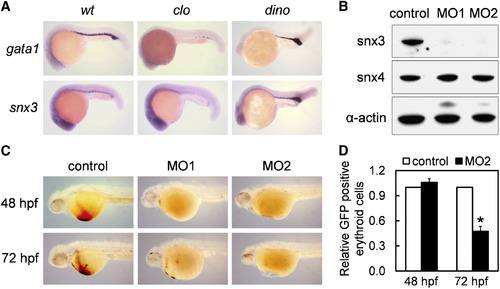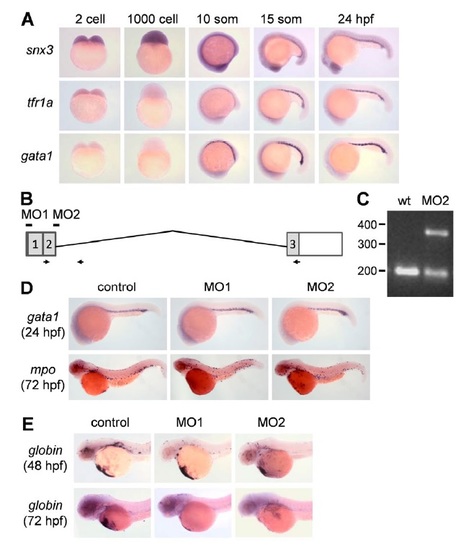- Title
-
Snx3 Regulates Recycling of the Transferrin Receptor and Iron Assimilation
- Authors
- Chen, C., Garcia-Santos, D., Ishikawa, Y., Seguin, A., Li, L., Fegan, K.H., Hildick-Smith, G.J., Shah, D.I., Cooney, J.D., Chen, W., King, M.J., Yien, Y.Y., Schultz, I.J., Anderson, H., Dalton, A.J., Freedman, M.L., Kingsley, P.D., Palis, J., Hattangadi, S.M., Lodish, H.F., Ward, D.M., Kaplan, J., Maeda, T., Ponka, P., and Paw, B.H.
- Source
- Full text @ Cell Metab.
|
Snx3 Is Required for Heme Production in Zebrafish Embryos (A) Whole-mount in situ hybridization detects expression of gata1 and snx3 in the blood island ICM in zebrafish embryos at 24 hpf. The ICM staining is absent in cloche mutants and is expanded in dino mutants. (B) Western analysis confirms efficient silencing of snx3 by a translation-blocking morpholino (MO1) and a pre-mRNA splice-blocking morpholino (MO2). The expression of snx4 and ±-actin control proteins was unaffected. (C) Injections of MOs against snx3 result in a profound anemia in zebrafish embryos at both 48 and 72 hpf. (D) Knockdown of snx3 in Tg(globin-LCR:eGFP) transgenic zebrafish leads to reduced number of erythrocytes at 72 hpf, but not at 48 hpf. Error bars represent SEM from three biological replicates. *p < 0.001 compared with the control morpholino. EXPRESSION / LABELING:
PHENOTYPE:
|
|
Morpholino-mediated knockdown of snx3 in zebrafish embryos specifically impairs heme production and erythroid lineage differentiation. (A) The expression profile of snx3 in different stages of early zebrafish embryos. snx3 zygotic transcripts are enriched in the ventral blood islands (intermediate cell mass, ICM) from around 10-somite stage, a pattern similar to that of tfr1a. In contrast to tfr1a, snx3 is expressed as a maternal transcript between 2- and 1000-cell stages. The erythroid transcription factor gata1 is presented as a control for primitive hematopoiesis. (B) MO1 and MO2 were designed to target the translational initiation site and the second exonintron boundary in snx3, respectively. (C) RT-PCR using primer set shown in panel (B) confirmed the presence of altered snx3 mRNA spliceforms in zebrafish embryos injected with MO2. (D) Whole-mount in situ hybridization indicated that initial specification of erythropoiesis (gata1) and myelopoiesis (myeloperoxidase or mpo) was not affected in the snx3 morphants. (E) Whole-mount in situ hybridization in snx3-morphant embryos showed normal and reduced expression of βe1-globin at 48 hpf and 72 hpf, respectively. EXPRESSION / LABELING:
PHENOTYPE:
|
Reprinted from Cell Metabolism, 17(3), Chen, C., Garcia-Santos, D., Ishikawa, Y., Seguin, A., Li, L., Fegan, K.H., Hildick-Smith, G.J., Shah, D.I., Cooney, J.D., Chen, W., King, M.J., Yien, Y.Y., Schultz, I.J., Anderson, H., Dalton, A.J., Freedman, M.L., Kingsley, P.D., Palis, J., Hattangadi, S.M., Lodish, H.F., Ward, D.M., Kaplan, J., Maeda, T., Ponka, P., and Paw, B.H., Snx3 Regulates Recycling of the Transferrin Receptor and Iron Assimilation, 343-352, Copyright (2013) with permission from Elsevier. Full text @ Cell Metab.


